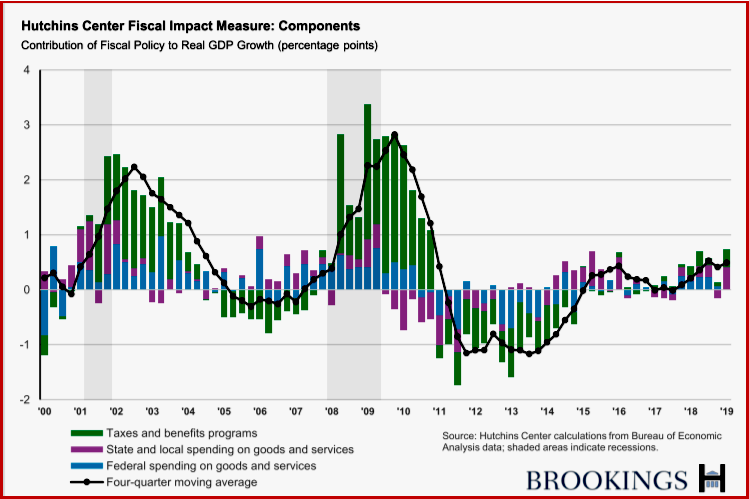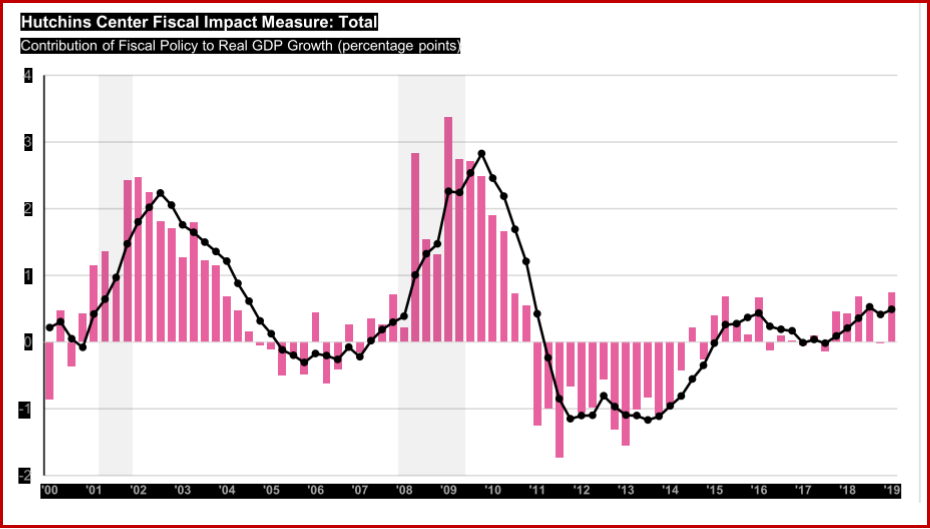
Click to Enlarge.
The Hutchins Center Fiscal Impact Measure (FIM) is now updated with the latest economic data. The FIM is a tool created by experts at the Hutchins Center to illustrate how much fiscal policy adds to or subtracts from overall economic growth, which grew at +3.2% in Q1, subject to revision according to data just released. This will call for further analysis in the coming days, but consumer spending was weak -real domestic final sales grew but 1.3% when annualized – and questions remain. For example, the Dow Jones industrial average gained a mere was off 0.06% last week. (View the updated FIM)
Government spending and tax policies – particularly at the state and local level – added three-fourths of a percentage point to growth in inflation-adjusted gross domestic product (GDP) in the first quarter of 2019, according to the latest reading.
The most recent data indicate that while the waning effects of federal legislation and the partial government shutdown in January 2019 weighed on some components of the FIM, investment by state and local governments has continued to add to GDP growth.

Contribution of Fiscal Policy to U.S. GDP – Hutchins Center. Click to Enlarge.
Federal spending has risen only modestly over the last four quarters and made no net contribution to GDP growth in the first quarter. Non-defense spending declined by 6 percent in the first quarter, partly reflecting the effects of the partial government shutdown. Increases in spending on national defense offset these declines, however, so that the net impact on GDP was about zero. The most recent FIM reading suggests the contribution to GDP growth from increased federal spending last year has diminished significantly in recent quarters.

About Ken Zino
Ken Zino, editor and publisher of AutoInformed, is a versatile auto industry participant with global experience spanning decades in print and broadcast journalism, as well as social media. He has automobile testing, marketing, public relations and communications experience. He is past president of The International Motor Press Assn, the Detroit Press Club, founding member and first President of the Automotive Press Assn. He is a member of APA, IMPA and the Midwest Automotive Press Assn.
He also brings an historical perspective while citing their contemporary relevance of the work of legendary auto writers such as Ken Purdy, Jim Dunne or Jerry Flint, or writers such as Red Smith, Mark Twain, Thomas Jefferson – all to bring perspective to a chaotic automotive universe.
Above all, decades after he first drove a car, Zino still revels in the sound of the exhaust as the throttle is blipped during a downshift and the driver’s rush that occurs when the entry, apex and exit points of a turn are smoothly and swiftly crossed. It’s the beginning of a perfect lap.
AutoInformed has an editorial philosophy that loves transportation machines of all kinds while promoting critical thinking about the future use of cars and trucks.
Zino builds AutoInformed from his background in automotive journalism starting at Hearst Publishing in New York City on Motor and MotorTech Magazines and car testing where he reviewed hundreds of vehicles in his decade-long stint as the Detroit Bureau Chief of Road & Track magazine. Zino has also worked in Europe, and Asia – now the largest automotive market in the world with China at its center.


US Economy Showing Some Growth in Q1
Click to Enlarge.
The Hutchins Center Fiscal Impact Measure (FIM) is now updated with the latest economic data. The FIM is a tool created by experts at the Hutchins Center to illustrate how much fiscal policy adds to or subtracts from overall economic growth, which grew at +3.2% in Q1, subject to revision according to data just released. This will call for further analysis in the coming days, but consumer spending was weak -real domestic final sales grew but 1.3% when annualized – and questions remain. For example, the Dow Jones industrial average gained a mere was off 0.06% last week. (View the updated FIM)
Government spending and tax policies – particularly at the state and local level – added three-fourths of a percentage point to growth in inflation-adjusted gross domestic product (GDP) in the first quarter of 2019, according to the latest reading.
The most recent data indicate that while the waning effects of federal legislation and the partial government shutdown in January 2019 weighed on some components of the FIM, investment by state and local governments has continued to add to GDP growth.
Contribution of Fiscal Policy to U.S. GDP – Hutchins Center. Click to Enlarge.
Federal spending has risen only modestly over the last four quarters and made no net contribution to GDP growth in the first quarter. Non-defense spending declined by 6 percent in the first quarter, partly reflecting the effects of the partial government shutdown. Increases in spending on national defense offset these declines, however, so that the net impact on GDP was about zero. The most recent FIM reading suggests the contribution to GDP growth from increased federal spending last year has diminished significantly in recent quarters.
About Ken Zino
Ken Zino, editor and publisher of AutoInformed, is a versatile auto industry participant with global experience spanning decades in print and broadcast journalism, as well as social media. He has automobile testing, marketing, public relations and communications experience. He is past president of The International Motor Press Assn, the Detroit Press Club, founding member and first President of the Automotive Press Assn. He is a member of APA, IMPA and the Midwest Automotive Press Assn. He also brings an historical perspective while citing their contemporary relevance of the work of legendary auto writers such as Ken Purdy, Jim Dunne or Jerry Flint, or writers such as Red Smith, Mark Twain, Thomas Jefferson – all to bring perspective to a chaotic automotive universe. Above all, decades after he first drove a car, Zino still revels in the sound of the exhaust as the throttle is blipped during a downshift and the driver’s rush that occurs when the entry, apex and exit points of a turn are smoothly and swiftly crossed. It’s the beginning of a perfect lap. AutoInformed has an editorial philosophy that loves transportation machines of all kinds while promoting critical thinking about the future use of cars and trucks. Zino builds AutoInformed from his background in automotive journalism starting at Hearst Publishing in New York City on Motor and MotorTech Magazines and car testing where he reviewed hundreds of vehicles in his decade-long stint as the Detroit Bureau Chief of Road & Track magazine. Zino has also worked in Europe, and Asia – now the largest automotive market in the world with China at its center.